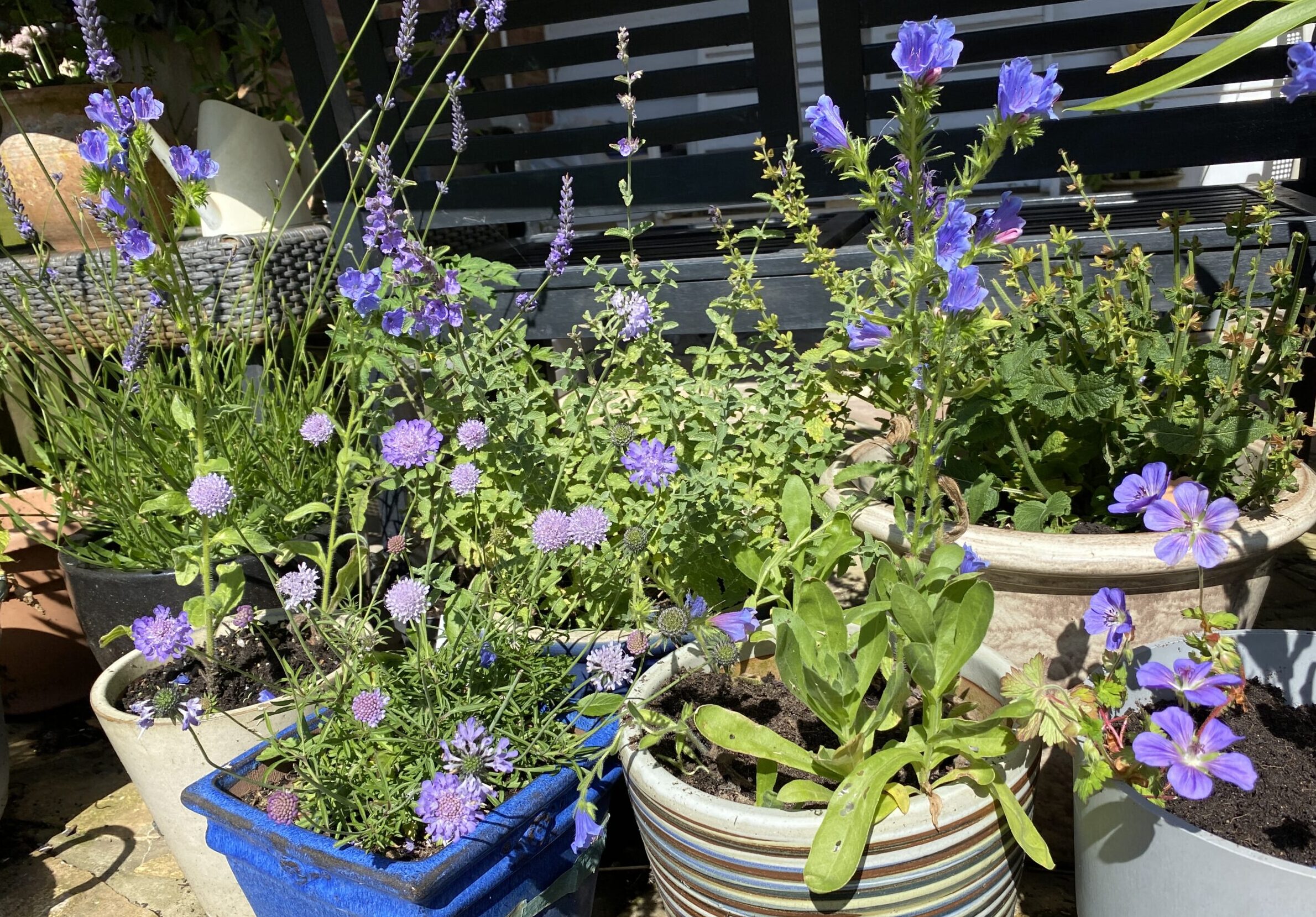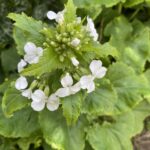Find out more about how this patio wildlife garden by the sea, did during 2024.
Do you have a lawn, and if so did you leave some as a meadow for No Mow May? How did this go?
No my garden is all patio, with wide planting beds and lots of pots. However I did plant some “wild flower mixes” in large containers. These often looked rather scruffy but did have a succession of different wildflowers such as campion, ox eye daisy, poppy and salad burnet. Many wildflowers are actually perennial, so you may need to wait more than one season to see them flower. I do have a wilder unplanted area behind my garden, which is mostly ox eye daisies but does look wonderful when in full bloom. This year they were joined by an enormous knapweed and some glorious ragged beauties – perennial sowthistles. By the compost bins I usually have to battle with the stinging nettles but this year had lots of hedge woundwort and bugle too which was very popular with the bees!
Which plants did you most enjoy during the year?
I grow a lot of things in pots, these can be easily updated as the year goes on, and I always have some in a covered seating area near the house that can make me smile all year round! I started the year with some pots of fragrant shrubs and bulbs such as crocus and muscari. These attracted lots of bees! By April there are more bulbs coming up and areas of my garden become full of wonderful self seeded plants such as celandine, foxgloves, honesty and garlic mustard, all brilliant for wildlife.
New this year were pots of a wonderful blue scabious, echium, geranium and a very prolific pot of English lavender (see photo above). Over Winter I’d also had to take out a huge rosemary bush that had just outgrown a raised bed. I replaced it with a bronze fennel, scabious, astrantia and a fantastic sea holly I was given.
I always love my herbs too and grow rosemary, sage, thyme, marjoram, chives, garlic chives, mint and fennel. Fennel is my favourite, so architectural and pretty, and towers over everything always covered in insects. Then in Autumn I see lots of birds on it, eating seeds and searching for insects. This year I had chiffchaff, willow warblers and reed warblers come by, presumably on their way south.
My crab apple tree struggles to survive so close to the sea, but it did have a good amount of blossom in Spring, a few fruits for the birds and is adored as a perch by the sparrows before they make a move on the birdfeeders! Honey suckle did well through the hedge and sedums and asters are great as we come into Autumn.
What didn’t do so well?
A lot of plants seemed slow and ultimately disappointing this year especially pots of tomatoes, cucumbers, sweet peas, courgettes etc! I grew lots of blooms for pollinators but the bees mostly preferred the self-seeded borage which became monstrously big and out of control!
It was a shame but I did have to be ruthless in the end and take most of it out. The rhubarb in a pot wasn’t doing too well until I re-potted it into an unwanted dustbin where it thrived! Nasturtiums and marigolds seemed slow to start, but then flowered for months!
My swift box was again full of rather messy starlings. Next year I need to try and block it up until the swifts arrive, and then play the lures to get them to investigate it!
What wildlife did you enjoy watching in the year?
There are always birds in my garden as I always have a birdbath and often put food out too. Regularly I get great flocks sparrows and starlings, dunnock and robin. Now and again I get wrens searching for spiders in hedges and walls and although my nest boxes weren’t used in Spring, a whole family of fledgling great tits turned up to shelter from the rain a few feet away!
Goldfinches are often overhead, as are wagtails but I avoid feeding larger birds because the crows and gulls can become a problem.
Bees and butterflies are always drawn to scabious, rosemary, chives. There didn’t seem to be a lot of butterflies about during the big Butterfly count, although I thought numbers started to pick up a few weeks later, particularly a lot of gatekeepers about.
Sadly I didn’t spot any frogspawn this year in my two ponds but did see a few frogs, and as usual, there were a whole family of slow worms keeping warm in at least one of my compost bins!
If you could give people just one essential tip for bringing wildlife into your garden, what would it be?
Supply fresh water all year round. A small pond is great if you can fit one in, but just a birdbath (or even an upturned dustbin lid or deep dish will be much appreciated. This will bring lots of birds into your garden, and maybe mammals too including foxes, badgers and hedgehogs.
Judy (Seaford Action for Nature)
We would love to know how your garden grew this year. Please let us know (you can answer the same questions above, or just write in your own way! Photos very welcome but not essential)

















